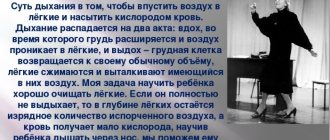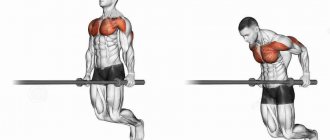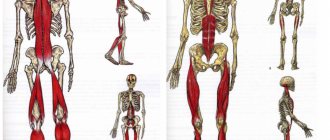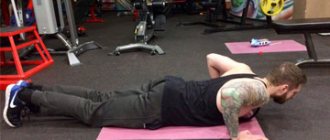The effectiveness of push-ups and other physical exercises depends on their correct execution. A common mistake many beginners and amateurs make is neglecting breathing techniques during training, since to achieve the desired effect you need to breathe correctly. Erratic inhalations, exhalations and air retention during physical activity can not only reduce their effectiveness, but also worsen well-being, and subsequently health.
General concepts and information
We can go on and on about how important it is to breathe correctly. In this case, it is necessary to have a completely healthy body. For example, with sinusitis you are unlikely to be able to breathe normally through your nose. And now directly to the topic.
Many of us play sports. Some do weightlifting, some do light lifting. Regardless of whether you are a swimmer, runner or wrestler, you need to breathe correctly. This applies even when it comes to ordinary push-ups and squats. The whole point is not that breathing that is disrupted during exercise harms the body, although this is one of the main causes of many injuries and consequences. You simply won't be able to do push-ups at full strength. Let's talk in more detail about how to breathe correctly when doing push-ups. There are quite a few nuances and important points here that we will try to consider with you.
Exhale correctly
The process of exhalation and the accompanying contraction of the lateral and abdominal muscles will add additional rigidity to your body, stabilize it and help tighten all the necessary muscles. An experienced athlete, without hesitation, uses proper breathing to his advantage while performing push-ups from parallel bars, from a wall or from the floor.
During impact push-ups from the floor, when the count goes even for one additional repetition, which ultimately contributes to an increase in the result, exhalation activates the release of additional adrenaline into the blood so that the body can cope with the critical load.
In addition, an athlete distorted by a grimace during such a shock press from the floor or from the uneven bars simply physically will not be able to inhale, since the body will reflexively react by relaxing and disorienting him.
Push-up technique
The first thing you need to start with is the push-up technique. The fact is that there are a huge number of variations of push-ups. For example, a narrow grip helps develop the triceps, a wide grip helps develop the pectoral muscles, and a medium grip helps develop both. Some people prefer to perform this exercise on one hand, while others do it not on their fingers, but on their palms. All this means that the technique can be anything, and breathing must be adjusted accordingly.
At first it will be quite difficult to understand how to breathe correctly when doing push-ups, but soon this process will become automatic, and you will not pay attention to it. If you do push-ups quickly, then you need to breathe faster, if slowly, then, accordingly, slower. In this article, we will look at the classic version and a few more popular ones, after which you will probably understand how to breathe correctly when doing push-ups, because there is nothing complicated about it.
What can you pump up?
Different positions of the hands in push-ups from the floor allow you to load different muscle groups. There are three load distribution options:
- you practice in the classic position, when your hands are slightly in front and almost at shoulder level. In such a situation, the load is evenly distributed between all muscle groups of the torso;
- wide stance of the arms allows you to concentrate the force to a greater extent on the outer part of the pectoral muscles and delta;
- narrow placement of the arms (close to the sides) allows you to pump up the triceps well.
Exercise and breathing
We have already figured out a little about the fact that an athlete’s breathing during push-ups depends on the technique of performing the exercises. But it is worth noting that this applies exclusively to frequency. The fact is that when performing any physical exercise, you need to find a breathing rhythm and stick to it until the end of the approach. The only exception is cardio exercise, where everything is somewhat more complicated.
Since breathing correctly when doing push-ups is extremely important, which we have also already dealt with, delays are not recommended. This applies to both heavy exercises, such as squats with a barbell, and lighter ones, such as push-ups with your own weight or weights. During the exercises, after you have taken the starting position, you need to concentrate. You probably know that you cannot talk or look around during push-ups. Why? The whole point is that breathing is lost.
Correct breathing technique
Correct inhalation during push-ups involves filling the lungs with air during a short downward movement, the stomach and chest should literally inflate. The accumulated air should be released slowly when lifting the body, using the entire volume using maximum effort.
The main mistake beginners make is holding their breath while performing a task; experienced athletes also make this mistake quite often.
The delay allows you to lift your own weight faster, however, in addition to the external side, there is an internal part of the problem. As a result of incorrect actions, internal organs receive less oxygen.
This technique contributes to the appearance of hypertensive loss of consciousness and rupture of blood vessels in the head. Simply because with a deep breath, which is required for training, the strengthening of the heart muscle increases. Physical tension leads to negative influences. It is compensated only by competent inhalations and exhalations. Correct execution of the task has a positive effect on the heart muscle, preventing negativity. In addition, when the muscles receive an insufficient supply of oxygen, its harmonious development should not be expected. There will be no increase in strength or size. Mastering proper breathing will help you avoid negative consequences, such as:
- muscle pain;
- injuries;
- stretching.
How to breathe while doing push-ups
And now we come directly to the consideration of our question. After you have taken the starting position, you need to concentrate. When you reach the lowest point, you gradually inhale. Exhale while lifting. In principle, the scheme is the same in all strength exercises. In the negative phase, inhale, in the positive phase, exhale. The first time may be very unusual, but you need to adapt to it. Over time, you will not notice the effort, as the process will become automatic. In general, now you know how to breathe when doing push-ups, but now let's go further and look at a few more important details that every novice athlete should know.
Contraindications for performing push-ups
Push-ups, like any exercise, can be harmful to health. The exercise should be excluded from training in the following situations:
- You have a tendency to have high blood pressure. This is due to the increase in pressure during push-ups.
- You have any spinal injuries, curvatures or other back problems.
- You experience problems with the joints of your hands: elbows, shoulders, wrists.
- You are a beginner and have not prepared for push-ups, have not warmed up, and are not familiar with the technique.
- You are overtired, feel weak throughout your body, feel unwell.
If you are overweight, you don’t need to give up push-ups, but it’s better to start the exercise with lighter options to reduce the load on your joints.
Push-ups are not a boring item from a standard physical education program, but a complex exercise that is useful not only for the upper body, but also for developing overall endurance and strength. Push-ups can be performed in any conditions and without special equipment. They are effective even if performed without any other exercises, but it is still advisable to include them as part of a comprehensive workout.
A person breathes when he sleeps and when he is awake, when he works and when he rests. Breathing is our life. Proper breathing is of particular importance when performing physical exercises. There are a lot of techniques, as well as activities, but one of the most popular exercises that everyone does, or at least knows how to do, is push-ups. And when performing it, it is important to observe breathing technique.
Correct breathing is the basis for everything
We have already figured out that there are negative and positive phases, at each of them you need to inhale or exhale. “Why this way and not the other way around?” - you ask. Everything is simple here. The fact is that during the exercise there is a certain load. If weighting is used, then it is even higher. If we swap breathing in the negative and positive phases, then we will additionally load the body during the difficult part of the exercise, when it is not necessary to do this. At the same time, a powerful exhalation in the positive phase will allow you to extend your arms with less effort. It is for these simple reasons that you need to perform the exercise with the correct technique. You know how to breathe correctly when doing push-ups. And now something else useful.
How to inhale and exhale correctly during push-ups?
When performing any strength exercises, it is recommended to release air from the lungs during maximum muscle tension, and let it in during the muscle relaxation phase. When performing an exercise on the uneven bars, the load on the arm muscles is more serious than when performing a gentle exercise on the wall.
The last option is democratic, since the load on the hands with this type of exercise can be easily adjusted due to different angles of inclination of the body relative to the wall. But the most popular and accessible method without the use of all kinds of devices using your own body weight is push-ups from the floor.
Regardless of the method, proper breathing will be the key to a later onset of fatigue and faster muscle recovery between repetitions and approaches. The more difficult it is to do push-ups, the deeper you have to inhale.
Maximum range of motion requires longer breath holding. In this case, it is more likely that the rhythm of the exercise itself organizes the sequence of breathing. It is almost impossible to make a mistake with the moment of the beginning of inhalation or exhalation, since the body intuitively suggests that the athlete’s body, contracting from muscular efforts, facilitates exhalation, and inhalation in this case would meet almost insurmountable resistance.
The athlete does not need to strictly regulate his breathing, because even if he makes a serious mistake and switches the phases of inhalation and exhalation, the negative consequences will not be clearly expressed or will not occur on the first approach. An inexperienced athlete will not immediately understand why he feels a little dizzy and his limbs feel heavy.
How to breathe when doing push-ups: reviews and recommendations
Now there are a huge number of “experts” on the Internet who have never tried push-ups in their lives, but they are already giving recommendations. It is hardly advisable to listen to such advice. This will not lead to anything good. By the way, it should also be noted that improper breathing has serious consequences. In particular, this applies to the functioning of the cardiovascular system. The load on the “engine” of our body increases significantly. Some athletes hold their breath during push-ups. As a result, the face turns significantly red, and capillaries may burst and the nose may bleed. But this is not the worst thing, since you can easily lose consciousness.
To prevent anything like this from happening to you, trust only trusted sources. Many athletes and even coaches recommend using Soviet literature on weightlifting and athletics for these purposes. There are useful tips on push-up technique, speed, number of repetitions and, of course, breathing. Thematic forums where there are many real professionals can be a useful source of information.
The role of breathing in exercise
Proper breathing helps compensate for the load on the heart and blood vessels, while preventing negative consequences.
Proper breathing during push-ups helps compensate for the load on the heart and blood vessels
If there is a deficiency in the supply of oxygen to muscle cells, regardless of the presence of physical activity, they cannot increase and their strength does not increase. This is an additional reason why you should not hold your breath while exercising. After mastering the correct breathing technique during exercise, the body will cope better with it, this will help avoid some negative consequences.
Breath! Do not breath
The condition of your cardiovascular system depends on whether you breathe correctly or not during push-ups. If you do this incorrectly, you can get serious health problems.
Inhalation should be done while performing the most difficult part of the exercise, precisely when maximum effort is needed. It will look like this: lowering down - inhale, raising up - exhale. To do this, we take the position necessary to perform the exercise: lower the body and inhale. Next, touch the floor with your chest. After this, you need to make a jerk and exhale at this moment. It is there that the greatest effort is supported by exhalation. You need to continue the exercise in the same rhythm.
This technique will help overcome the stress on the body during the exercise. Its essence is as follows:
- Inhalation is an increase in intrauterine and blood pressure, which puts a strain on the cardiovascular system.
- Peak load is a great challenge for the body. And if you supplement it with inhalation, the consequences will be unpleasant.
- When you exhale, you can concentrate better.











